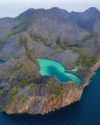Indo-Pacific lionfish (Pterois volitans) have invaded many popular scuba diving locations in the Atlantic and Caribbean.

Aside from causing possible harm to swimmers and divers, this voracious predator can dramatically affect populations of native marine animals in the ecosystems to which they have been introduced.
Lionfish are venomous and belong to the Scorpaenidae family. These fish and those of the Synanceiidae family (such as Synanceia, or stonefish) comprise most of the existing venomous fish. Without putting life at risk, envenomations caused by scorpionfish and lionfish can cause significant symptoms due to the systemic action of their venoms.
Lionfish have spines that are covered by an epithelial sheath containing venom-producing glands in the grooves of the upper two-thirds of the long and slender spines. The dorsal fin has 12 or 13 rays or spines, the pelvic fin has two, and the anal fin has three. When the ray of the fin penetrates the victim’s skin, venom flows to the wound. Possible contact with various marine life occurs during diving, fishing and food handling. Even though most fish stings are benign, some lionfish stings require urgent medical treatment.
Bu hikaye Asian Diver dergisinin Issue 02 - 2019 sayısından alınmıştır.
Start your 7-day Magzter GOLD free trial to access thousands of curated premium stories, and 9,000+ magazines and newspapers.
Already a subscriber ? Giriş Yap
Bu hikaye Asian Diver dergisinin Issue 02 - 2019 sayısından alınmıştır.
Start your 7-day Magzter GOLD free trial to access thousands of curated premium stories, and 9,000+ magazines and newspapers.
Already a subscriber? Giriş Yap

The Sea Specialist: An Interview With Bret Gilliam
Most people learn to crawl before they walk, but there is a man who learned to swim before taking his first steps. Diver, entrepreneur, writer, athlete, maritime specialist – Bret Gilliam is the complete package. Just add water.

The Best Of Diving In Southeast Asia: Explore The Amazon Of The Seas
Southeast Asia encompasses the world’s most biodiverse reefs and some of the best diving anywhere on the planet. From the tiniest and rarest critters to huge fish schools and the biggest pelagics, the region has it all, and there’s something to suit divers of any level.

Below With David Doubilet & Jennifer Hayes
Best known for their work with National Geographic, David Doubilet and Jennifer Hayes came together to discuss their work with the youth, and, as Jennifer put it, “submerging with the emerging talent”.

Underwater Images For The Giant Screen
Howard and Michele Hall are best known for their success in underwater IMAX filmmaking.

Journey To Filming For National Geographic Wild Brazil
Cristian is an acclaimed and highly versatile Brazilian wildlife filmmaker who works both underwater and topside.

Breaking The Barrier: The World's Deepest Dive
David Strike shared a brilliant presentation about the history of deep diving and how Lt. George Wookey achieved the world’s deepest dive in 1956 using a surface-supplied rebreather.

Dive the Golden Land
The Best of Diving In Southeast Asia

OFFICIAL LAUNCH OF BLUE HOPE
Top Session of the Week (14,319 (Views) / 42,831 (Reach)

MEET THE (MARINE) MAMMALS
MEET THE (MARINE) MAMMALS

Fashion Faux Pas
What can be done to mitigate the impact of the garment industry on our oceans?